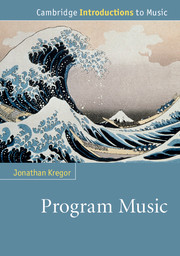Book contents
- Frontmatter
- Contents
- List of Figures
- List of Music examples
- List of Tables
- Acknowledgments
- Note on the text
- Introduction
- Chapter 1 Characters, topics, and the programmatic battlefield
- Chapter 2 Expression, musical painting, and the concert overture
- Chapter 3 Berlioz and Schumann on music and literature
- Chapter 4 Liszt and the symphonic poem
- Chapter 5 The New German School and beyond
- Chapter 6 Excursus: Faust
- Chapter 7 Programmatic paths around the fin de siècle: Mahler and Strauss
- Chapter 8 Programming the nation
- Chapter 9 “Ars Gallica”
- Notes
- Guide to further reading
- Index
Chapter 1 - Characters, topics, and the programmatic battlefield
Published online by Cambridge University Press: 05 January 2015
- Frontmatter
- Contents
- List of Figures
- List of Music examples
- List of Tables
- Acknowledgments
- Note on the text
- Introduction
- Chapter 1 Characters, topics, and the programmatic battlefield
- Chapter 2 Expression, musical painting, and the concert overture
- Chapter 3 Berlioz and Schumann on music and literature
- Chapter 4 Liszt and the symphonic poem
- Chapter 5 The New German School and beyond
- Chapter 6 Excursus: Faust
- Chapter 7 Programmatic paths around the fin de siècle: Mahler and Strauss
- Chapter 8 Programming the nation
- Chapter 9 “Ars Gallica”
- Notes
- Guide to further reading
- Index
Summary
In his massive Musikalisches Lexikon, the German theorist Heinrich Christoph Koch described the curious, niche genre of “Simphonies à programmes,” or “programmatic symphonies,” as follows:
A category of music, which remains little explored, whereby the composer sets for himself the goal of representing or depicting by tone painting alone certain historical events without the assistance of the poetic arts. Despite apparently being a German invention – since [Carl Ditters von] Dittersdorf, [Antonio] Rosetti, and [Joseph] Haydn were undoubtedly the first to tackle it – there has yet to be agreement on an appropriately artistic German name for the genre. Moreover, with the exceptions of Dittersdorf’s “Four Ages,” “Phaethon,” and other [“Ovid” Symphonies], Rosetti’s Telemachus, and Haydn’s Die sieben letzten Worte unseres Erlösers am Kreuze, no other examples of this genre are known, at least among the public.
In order for this genre to be afforded due respect, however, the question must first be answered: whether it is within the limits of music to represent historical topics, or at the very least, to what extent a historical event can serve as the basis for expressing musical sentiments (aroused by the historical event) without the assistance of the poetic arts.
Published in 1802, the Lexikon sits at a crossroads: It assesses numerous developments in music of the recent past, especially the last fifty years, in which the symphony and string quartet came into their own, serious opera underwent radical reforms, and music had abandoned affect and mimesis in favor of sentiment and rhetoric. At the same time, Koch’s tome anticipates many of the issues that would occupy musicians and critics for the rest of the nineteenth century and even beyond, including the relationship between poetry and music, the aesthetic and social position of instrumental music (especially in relation to opera), and the role of folk and national music in the arts, among others.
- Type
- Chapter
- Information
- Program Music , pp. 7 - 38Publisher: Cambridge University PressPrint publication year: 2015

